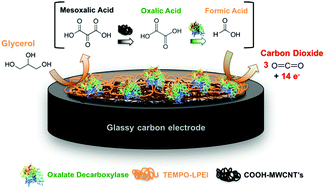Polymer-immobilized, hybrid multi-catalyst architecture for enhanced electrochemical oxidation of glycerol†
Abstract
The development of a hybrid, tri-catalytic architecture is demonstrated by immobilizing MWCNTs, TEMPO-modified linear poly(ethylenimine) and oxalate decarboxylase on an electrode to enable enhanced electrochemical oxidation of glycerol. This immobilized, hybrid catalytic motif results in a synergistic 3.3-fold enhancement of glycerol oxidation and collects up to 14 electrons per molecule of glycerol.



 Please wait while we load your content...
Please wait while we load your content...